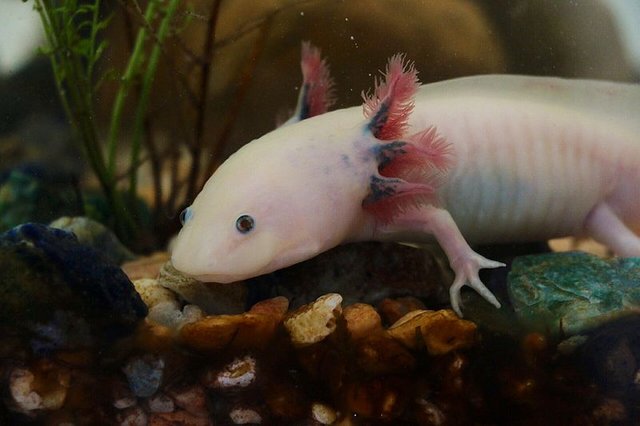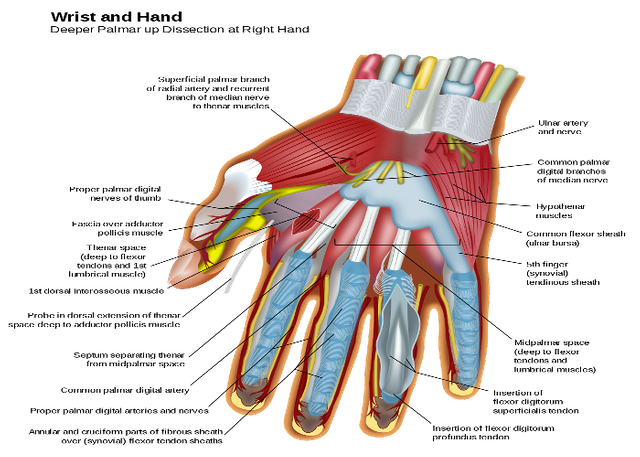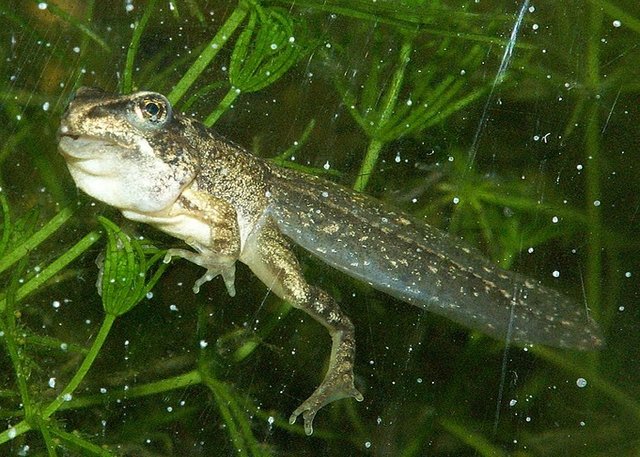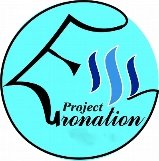Regenerative Medicine: Understanding The Secrets Of Regeneration In Axolotl To Inspire Regrowing Human limbs After Amputation
It is a popular knowledge worldwide that the only treatment option available for amputees is replacement with prosthetic, which of course, confer a level of support and form to amputees but seriously lacking essential characteristics of viable biological limbs. And thus constituting a source of concern to orthopedists, neurologists and other researchers in the field of regenerative medicine, who are of the opinion that we could just regrow human limbs in the future instead of relying on the ineffective artificial solutions.

[Abystoma mexicanus. Source: Wikimedia commons. Author: Amandasofiarana. CC BY-SA 4.0 licensed]
To attempt regrowth of lost limb in humans, scientists recognize the need to not only understand the concept of regeneration but also how the entire process takes place in those animals that exhibit the ability to regrow lost limbs. And hence, understanding the biochemical processes of regeneration in those organisms that exhibit it, shall form the crux of this article, and I sincerely hope you have an enriching experience reading it.
Animals with regenerative ability
Animals can be vertebrates (with a spine) or invertebrates (without a spine). Invertebrates are generally regarded as masters of regeneration because they can regrow their entire bodies from any tiny fragment of their original selves. Flatworms and hydra are good examples. Frogs and axolotl (Abystoma mexicanus) are some vertebrates that can regenerate their limbs. However, frogs lose this ability after they grow into adult frogs from tadpoles. Axolotl, which is a species of aquatic salamander, retains this ability throughout life, making it the most suitable tool for regenerative research studies. Other than limbs, Axolotl can regrow its heart, spinal cord and most other organs.
Mammalian vertebrates are known to lack the ability to fully regenerate lost appendages. However, the emphasis here is on fully; in other words, they can regrow lost limbs to some extent, including human beings. While mice have been observed to possess the ability to regrow the tips of its toes, there exists some clinical studies to support that humans can regenerate the tip of their fingers (both skin and bone). Mice lose this ability when amputation occurs further up the foot whereas humans, as well, lose their regenerative ability when the cite of amputation is closer to the palm. *This is probably the first time you come across this fact, isn't it? That is actually part of what makes steemit an awesome place to be!😂

[Human fingers has been shown to sometimes possess regenerative ability. Source: Wikimedia commons. Author: ThePhotographer. CC BY-SA 3.0 licensed]
How regeneration works in axolotl
As I said earlier on, among all vertebrates, axolotl is one-of-a-kind. Its incredible regenerative capacity makes it the choice of researchers who are trying to understand the mechanisms involved in this evolutionary marvel on the premise that knowledge gained will facilitate the designation of an effective approach (so take say) to replicate such ability in humans.
Once a limb is amputated in axolotl, a clot of blood cells quickly forms at the site of amputation to stop bleeding. Then cells rapidly aggregate to cover the plane of amputation by forming a structure known as a wound epidermis. Thereafter, both the cells of epidermis and cells within it will start to grow and divide rapidly to form a cone-shaped structure called blastema. Blastema cells have unique ability to lose their identity and become stem cells. This is known as de-differentiation. Blastema and its cells will continue to de-differentiate, divide and eventually grow into a functional limb which is a perfect copy of lost limb with no sign of previous damage. Amazing! Isn't it?

[Tadpole undergoing metamorphosis to become frog. Source: Wikimedia commons. Author: Viridiflavus. CC BY-SA 3.0 licensed]
Limiting factors of regeneration in axolotl
For us to successfully induce the regenerative ability of axolotl in humans, we must get intimately familiar with changes that take place during regeneration. One method that has proven to be effective in this regard is finding the molecular tweaks that can cause an axolotl to lose its ability to regrow lost limb, and thus reveals regeneration's most important components and contributors. Using this approach, some biochemical elements that are important in both immune and nervous systems have been found to be the important drivers of regeneration; including:
Macrophages: macrophages are immune cells that are very essential in immune response following injury. Usually, they arrive at a wound site between 2 to 4 days to engulf and digest pathogens and other infectious agents, causing both inflammatory and anti-inflammatory signals to initiate healing. In a study that was published in the Journal Proceedings of the National Academy of Sciences, the role of macrophages in axolotl's limb regeneration was studied, and it was found that depleting the levels of macrophages cells in an axolotl will result in its loss of regenerative ability. However, when the levels of macrophages are fully restored, regeneration was found to resume again, showing that macrophages may be essential for regeneration. Go here to read more on this.
Nervous system: Manipulating the nervous system has been found to interrupt the process of regeneration. Many studies have shown that surgically removing nerves from the limb of axolotl before amputation, impedes their ability to regenerate the lost limb. Researchers are yet to understand why this is so. Read more here
1.png)
[Immune system cell of macrophage. Source: Wikimedia commons. Author: A. Rad etc al. CC BY-SA 4.0 licensed]
The above approaches being explored in an attempt to get to the roots of the essential components of regeneration, involved excision of important body parts. For this reason, researches are exploring other alternatives that will involve taking a deeper look into the genetics of the animals. One of such alternatives is to find out how many times axolotl limbs are able to regenerate after repeated amputation. In this regard, it was discovered that amputated limbs failed to regrow after the limbs were repeatedly amputated to the 5th time.
...when the limbs that could not regenerate were studied further, researchers again found extensive scar tissue build-up, paralleling what is often seen in human injuries. By comparing the genes that were turned on or off when the axolotl’s limb wasn’t able to regrow, scientists have found more molecules and processes to study that hold promise for kick-starting regeneration in humans. Perhaps one day, drugs can be made to modulate these genes, causing them to turn on and help a human limb to regrow after amputation. Source
Conclusion
Although we have not yet been able to come up with something that is capable of inducing limb regeneration in human beings but it will be at our disadvantage if we fail to understand the concept of regeneration taking place in organisms that possess such ability. To this end, taking a deeper look into the genetics of the regenerative ability possessing organisms using relevant genetic tools will ensure we understand the molecular basis of regeneration. And perhaps may be able to isolate critical components that could be engineered, manipulated and transfered into human beings to induce regeneration in the future. Such a breakthrough will restore the joy of millions of amputees as well as people with spinal cord injury living in different parts of the world. Researchers in this field see no reason this potential success will not be actualized in 10, 20 years time. Thanks.
References for further reading
- Regeneration: The axolotl story
- A brief history of the study of nerve dependent regeneration
- Macrophages are required for adult salamander limb regeneration
- Chopped: how amputated fingers sometimes grow back
- What the axolotl can teach us about regrowing human limbs
- Missing parts? Salamander regeneration secret revealed
Yours truly,
@eurogee
Do You Blog About Science, Technology, Engineering, and Mathematics? If Yes, Patiently Read The Below Info


Join Euronation Community on Telegram and whatsapp through the below links to socialize with larger steemit community:

No Witnesses = No Steem Blockchain; If You Truly Love Here, Vote For Witnesses NOW!
Click This Link To Vote Now


First of all, Axolotl are from my country of origin, and they are great.
In the future, we could simply grab the regenerative gene from these type of auto-healing reptiles and insert it into the appropriate cells in a splice-like manner so stimulate complete regeneration of any part of the body, just like a reptile.
Thank you for your post, it was really informative.
That would make us a sort of super human or something. Or don't you think so?
Yes I think it will, then again I think that in the future with genetic engineering we all are going to be super humans anyway.
Longevity is in the offing. I think so too.
It's great to have you here
If only humans can have regenerating abilities..
Anyway science im sure is finding a way
Indeed
I know about the Axolotl and its special abilities. Found out about it during my top 5 series then.. I read about it just didn't have the time to write about it. So, I let it slide...
Thanks for bringing back it to my memory, @eurogee of euronation.... Lol
Really. Good to know. Thank you
This is incisive and didactic. I read sometime ago that research for immortality is on going. The proposition is that by year 2045, man may choose to die or not except by means of accident or other unnatural forms of death. The argument against it was mainly from religious perspective. The last positive argument was coming from the angle of regeneration. They argued that if scientists can go into research and know how to bring about regeneration to different body parts, it would tend to corroborate their theory of immortality.
This your article made me to remember this. Was a nice read.
Thank you for visiting
Hi @eurogee!
Your post was upvoted by utopian.io in cooperation with steemstem - supporting knowledge, innovation and technological advancement on the Steem Blockchain.
Contribute to Open Source with utopian.io
Learn how to contribute on our website and join the new open source economy.
Want to chat? Join the Utopian Community on Discord https://discord.gg/h52nFrV
Congratulations @eurogee! You have completed some achievement on Steemit and have been rewarded with new badge(s) :
Click on the badge to view your Board of Honor.
If you no longer want to receive notifications, reply to this comment with the word
STOP